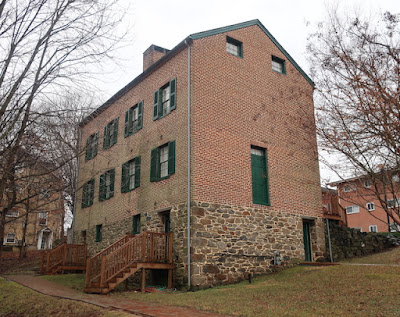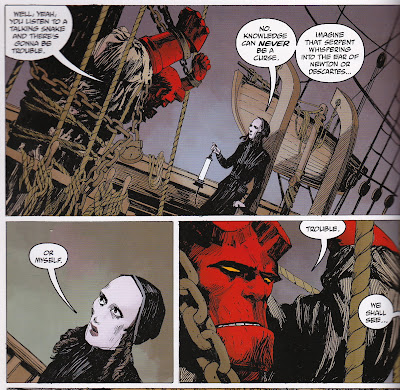A popular event in our local scouting community is the Klondike Derby. The derby is an outdoor event held in January inspired by the
Klondike Gold Rush of the late 1890s. Around 100,000 prospectors rushed to northern Yukon when gold was discovered in 1896. Everyone had an adventure though very few gained wealth. The spirit of adventure lives on in the Klondike Derby.
The organizers make two routes on the derby--one for the younger Cub Scouts, another for the older Cubs and Boy Scouts. My son is a Webelos, so he took the second route. Our Cub Scout Pack has a sled on wheels that could run in snowy or non-snowy conditions. We were lucky with the weather and had a fairly dry and warm (high 50s) day for our run. The Boy Scout trail runs about three miles along the trails of
Patapsco State Park, with various activity stations along the route.
 |
| My boy with the sled |
Unfortunately, a few of the boys who had signed up couldn't make it, so our den had only two boys. I was a little disappointed but we did get through the various stations fairly quickly.
 |
| Two-man sled |
The first station was Inspection, where some older scouts made sure we had enough supplies (food, water, first aid kit, etc.) to make the trip. We also had to give our den cheer. Not having thought up one beforehand, we used the pack anthem as our den cheer, which worked well enough.
The second station was the two-man saw, which worked out perfectly with our boys. After a few pointers on safety and technique, the boys got to work. They sawed through a small log with a large saw.
 |
| Supervised cutting |
 |
| Whose turn is it to pull? |
 |
| Coffin-shaped saw container |
 |
| Plenty of wood nearby for practice |
The next station was also potentially deadly--Axe Safety. The older boys taught general blade safety, like making sure no one is close enough to get hurt when you open a pocket knife or swing an axe. After learning some axe technique, the boys chopped some fallen logs.
 |
| Safety training |
 |
| Ready to cut |
 |
| Chopping |
My favorite part was the hot chili served by the Boy Scout troop sponsoring the Axe Safety station. The chili was only for the grown-ups, so we'd have something to do while the boys did the real work.
The next station was the Mayor's Tea. Here, the scouts had to boil a cup of water on an open fire and make tea for the mayor. Seattle Mayor William Wood resigned his post and joined the prospectors on their rush north and he is commemorated (sort of) here. The stand-in mayor taught the boys the best way to build a chimney-style fire along with other tips to make a good fire.
 |
| Mayor teaching fire techniques |
 |
| Showing a good piece of wood |
We were given a wax-coated paper cup and a tea bag and told to come back with a cup of tea. They assured us the cup wouldn't burn in the fire.
The boys gathered wood and built a good pile in an iron pan sitting on a rock.
 |
| Adding kindling and fuel |
 |
| Using an egg-crate starter |
 |
| Using a match, pretty easy |
 |
| The fire begins |
 |
| Trying to heat the cup by hand, not so easy |
 |
| Cup nestled in the fire |
Now, I don't want to say the people running the station were wrong, but our fire must have been hot enough to get the top of the cup (where there was no water) to catch fire and start burning. We tried to remove the cup, resulting in some of the flame reaching the nearby dry grass. While the two parents kept stomping out the fire's attempt to spread, the boys went to find a bucket of water. After a harrowing thirty seconds, a pail of water was brought over and we were able to extinguish the potential forest fire. I was too busy on fire control to get any pictures! The water in the cup did get lukewarm but we were too shy to offer it to the mayor, especially since bits of the burnt part of the cup were floating on top. We did get good marks for the station because nobody panicked and we kept the situation under control.
We moved on to the next station, which ironically enough was Outdoor Ethics. One big idea is leaving things the same as we found them and to have safe practices with tents and cooking fires. I think they should reverse the order of the stations for next year.
 |
| Learning about outdoor ethics |
 |
| Pointing out things wrong with the tent set-up |
The next station developed an important skill for all gold rushers and outdoors people--building a shelter from natural materials. This station was a lot of fun for the boys, who were proud to show off their accomplishment.
 |
| Building a shelter |
 |
| In the shelter |
 |
| Another nearby shelter |
A longish walk brought us to the next station where the boys were challenged to make matchless fires. That is, they weren't allowed to use matches. We brought flint and steel with us but my son wound up using the station's equipment. We didn't mention how things went with the Mayor's Tea.
 |
| Tinder in an aluminum pan |
 |
| Getting the right starting material |
 |
| The fire gets going |
Everything went well here, except that this station was another one that offered treats to the parents. I had a donut. My son saw me eating it. Once he finished making the fire, he asked if I had any left. Sadly, I did not. I promised to get a donut on the way home.
The next station was first aid, a common need in the Yukon and a handy skill for anyone to have.
 |
| First aid station (learning first aid, not receiving it) |
Climbing a tough hill, we came to the basic knots station, which was a breeze for our experienced scouts.
 |
| Learning knots |
One final push got us further up the hill to the two final stations--lashing and map reading.
 |
| Two stations right next to each other! |
Lashing taught the boys how to tie sticks together securely. The boys worked together to make a goal post and then got to kick a football to try and score.
 |
| Lashing logs together |
 |
| Lining up to kick |
 |
| My son kicks |
 |
| His second kick |
Right across from the lashing station was Ulcer Gulch canteen, where snacks and food could be bought. By this point, the day was almost done, so all the donuts were sold out. I bought my son a bag of chips as a substitute. He was happy with that.
The final station was map reading. I didn't see any of the details here because I chatted with the troop members and enjoyed some free lemonade they offered (they also had coffee, tea, and hot cocoa but the day was too warm for that).
 |
| Some map skill |
We had a lot of fun at the Klondike Derby and may try it out again next year.
 Runaways Volume 2: Teenage Wasteland written by Brian K. Vaughn, pencils by Adrian Alphona and Takeshi Miyazawa, inks by David Newbold and Craig Yeung, colors by Brian Reber and Christina Strain
Runaways Volume 2: Teenage Wasteland written by Brian K. Vaughn, pencils by Adrian Alphona and Takeshi Miyazawa, inks by David Newbold and Craig Yeung, colors by Brian Reber and Christina Strain
























































